Old Buildings, New Fixes: 10 Sustainable & Affordable Innovations to Keep Existing Homes in Urban India Cool
In 2024, India reported over 48,000 cases of heatstroke and 159 heat-related deaths — a stark sign of how rising temperatures are beginning to impact everyday life.
But alongside the heat, something else is gaining momentum: a wave of climate-conscious innovation. A group of young minds from across Indian institutes have come up with a range of clever, climate-responsive solutions — each designed to cool India’s buildings and move the country towards a resilient future.
Solar Decathlon India (SDI), an annual competition for undergraduate and postgraduate students, sees the coming together of young innovators who rejig avant-garde solutions with simple tweaks — think ceiling panels made from mycelium waste, terracotta cone-based coolers, and jali (lattice) shading devices, all in a bid to come up with net-zero solutions for India’s climate crisis.
 In 2024, India reported over 48,000 cases of heatstroke and 159 heat-related deaths, (Image for representative purposes)
In 2024, India reported over 48,000 cases of heatstroke and 159 heat-related deaths, (Image for representative purposes)
Commending their sense of “agency and purpose”, Prasad Vaidya, director and spokesperson, Solar Decathlon India, applauds the eco-conscious literacy prevalent among these young minds. They are not deterred by the mercurial nature of climate-induced problems, instead, it only furthers their resolve.
Having observed the quiet confidence among these students over the years, as they give form to trailblazing innovations, Prasad says, “What counts is that they have understood the problem. They have a solution that may not be perfect, but one that is in the works; one that they are looking at turning into a business model.”
Driving energy-efficient cooling to shape a sustainable India
A 2024 survey conducted by the Yale Program on Climate Change Communication (YPCCC) revealed that the Indian outlook towards the future is coloured with worry.
Where should the starting point for a mitigation plan begin?
As the adage suggests, it all begins at home.
The organizers of Solar Decathlon India, Alliance for an Energy Efficient Economy (AEEE) – India’s leading policy support and implementation organisation catalysing the responsible use of energy for a climate-resilient and energy secure future, and Indian Institute for Human Settlements (IIHS), a national knowledge institution that is committed to the equitable, sustainable, and efficient transformation of India’s cities, towns, and villages, beckons us to turn our gaze towards our buildings, which account for three percent of India’s energy and process-related carbon dioxide emissions.
Currently, only 10 percent of Indian households have air-conditioning.
But, the solution does not lie in scaling this number — this runs the risk of overburdening power grids. Instead, could we look at shifting the goalposts from conventional cooling technologies to more sustainable alternatives?
This is exactly the mindset shift encouraged at SDI, compelling students to come up with low-energy, affordable, user-friendly products that people can install without hiring engineers or technicians. The premise here is retrofitting.
“The word ‘retrofit’ conjures up images of significant components of buildings being removed and new stuff being added. But that’s not what we do in India. Instead, people are in the habit of visiting a shop, buying something they need, and asking a local technician to install it,” reasons Prasad. He adds that to this end, retrofitting these technologies essentially means introducing them in existing residential structures without extensive modifications to the framework of the building, thus marking a pivotal change
Innovations with the potential to ripple into impact
1. COOALA: Portable Water-Cooled AC
Picture a woman hard at work in her home kitchen, one of the thousands in the metropolitan area where she lives. As roti after roti (Indian flatbread) pile high onto the plate, the temperature rises in proportion. The kitchen mimics a furnace. The heat within is exacerbated by the stove on which the rotis cook. This is the lived reality for most women in India.
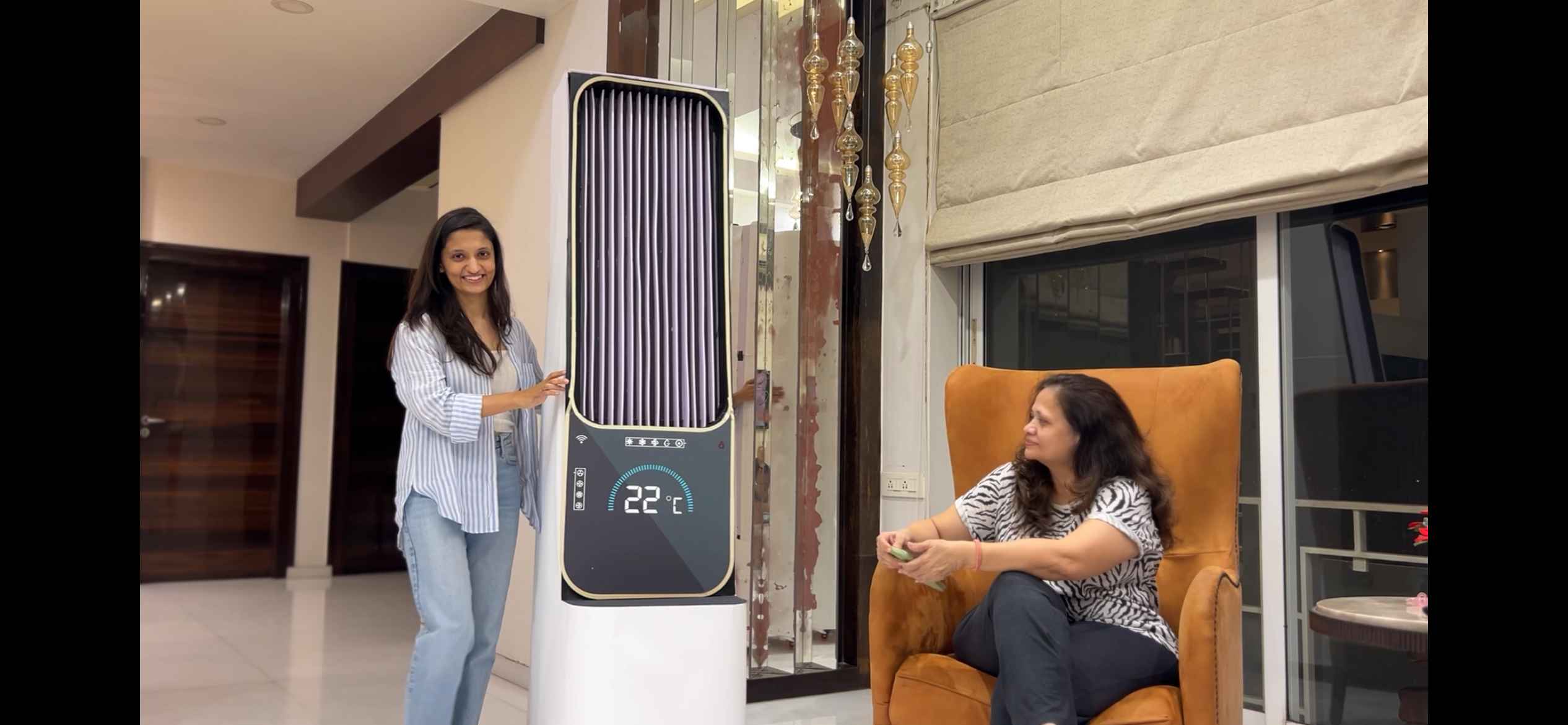 The portable air conditioner COOALA works on the principle of temporal heat dissipation with a dual compressor cycle
The portable air conditioner COOALA works on the principle of temporal heat dissipation with a dual compressor cycle
At the SDI Challenge, a team of students led by IES (Indian Education Society) College of Architecture, Mumbai, came up with a unique idea. They designed a portable air conditioner called ‘COOALA’.
What made it stand out? It doesn’t need a pipe going through the window. That means no technician is required for installation. Plus, it can be easily rolled from one room to another.
No surprise — it won over the jury instantly.
The device works on the principle of temporal heat dissipation with a dual compressor cycle, thus matching the cooling performance of a typical one-and-a-half-ton room AC.
2. Bloom: DIY Passive Cooling Module
The flasher-based dynamic cooling prototype could well be a template for how cooling can be achieved in residential spaces without relying on traditional air conditioners. The brainchild of students from Visvesvaraya National Institute of Technology (VNIT) in Nagpur, ‘Bloom’ is a modular, do-it-yourself (DIY) kit capable of achieving an average temperature differential of three degrees Celsius post-installation.
 ‘Bloom’ is a modular, do-it-yourself (DIY) kit capable of achieving an average temperature differential of three degrees Celsius
‘Bloom’ is a modular, do-it-yourself (DIY) kit capable of achieving an average temperature differential of three degrees Celsius
In the long run, the device is designed to help save money and power. Bloom’s operational costs are Rs 79 per month, leading to substantial savings compared to the Rs 1,200 to Rs 2,000 monthly expense of a standard 1-ton, three-star AC unit.
3. MushCool: Mycelium Ceiling Panels
Who could have imagined that ‘fungi tiles’ could be an antidote to India’s heat crisis? Research indicates that mycelium-bound composites are more energy efficient than conventional building insulation materials like expanded vermiculite. They possess thermal conductivity comparable to conventional insulating materials like glass wool and extruded polystyrene.
 The MushCool panels are eco-friendly, modular, affordable, and easy-to retrofit
The MushCool panels are eco-friendly, modular, affordable, and easy-to retrofit
The ‘MushCool’ innovation, which is ceiling panels made from mycelium, oyster mushroom spores and organic waste such as sugarcane bagasse, an agricultural byproduct — by the students from Bengaluru’s RV College of Architecture, RV College of Engineering, and RV University, School of Design and Innovation, wield these properties of mycelium. The resulting panels are eco-friendly, modular, affordable, and easy-to retrofit.
4. Sustaina Shades
Sugarcane bagasse, clay, paper pulp, aloe vera, lemongrass, and multani mitti (a type of clay) have a dual vantage. They are biodegradable and most of them (sugarcane bagasse, clay, paper pulp and aloe vera) have a cooling effect by nature. The ‘Sustaina Shades’ devised by the students of the Sri Venkateshwara College of Architecture, Hyderabad and B. V. Raju Institute of Technology, also in Hyderabad, draws from the intersection of these properties.
These shades are optimal for semi-open community spaces and claim to reduce indoor temperature by up to six and a half degrees Celsius.
5. Terracool: Desiccant Cooling System
Here’s an innovation that’s bringing the coolant properties of terracotta out of the shadows, ‘Terracool’, a hybrid wall module combining desiccant-based dehumidification, evaporative cooling, and solar power.
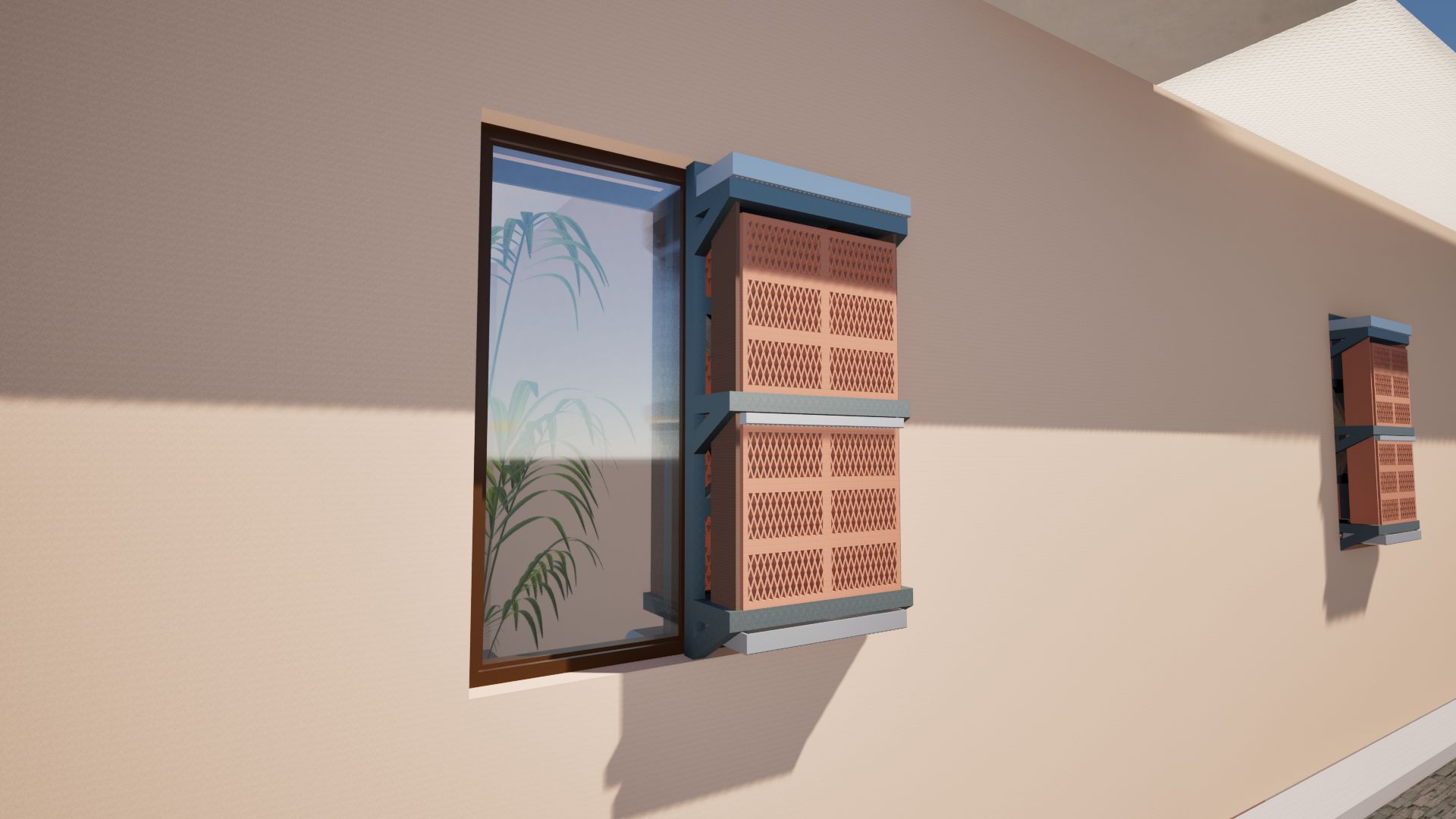 Terracool is hybrid wall module combining desiccant-based dehumidification, evaporative cooling, and solar power
Terracool is hybrid wall module combining desiccant-based dehumidification, evaporative cooling, and solar power
Designed by the students of the Indian Institute of Technology Delhi, this uses desiccant technology to dehumidify and cool indoor spaces, reducing indoor temperatures by up to seven degrees Celsius with a 10 percent reduction in humidity.
6. VAYU: Ceiling Fan Retrofit for Cooling and Dehumidification
Visceral and confronting is how the jury would describe the solutions ideated by the young innovators. Take, for instance, ‘VAYU,’ a low-cost, personalised retrofit device that couples cooling and dehumidification through a desiccant wheel technology that helps control humidity and provides enhanced energy efficiency. Devised by the students of Manipal School of Architecture and Planning and Manipal Institute of Technology, Karnataka, the device is capable of operating temperatures between 22-25 degrees Celsius and reduces humidity by approximately five percent.
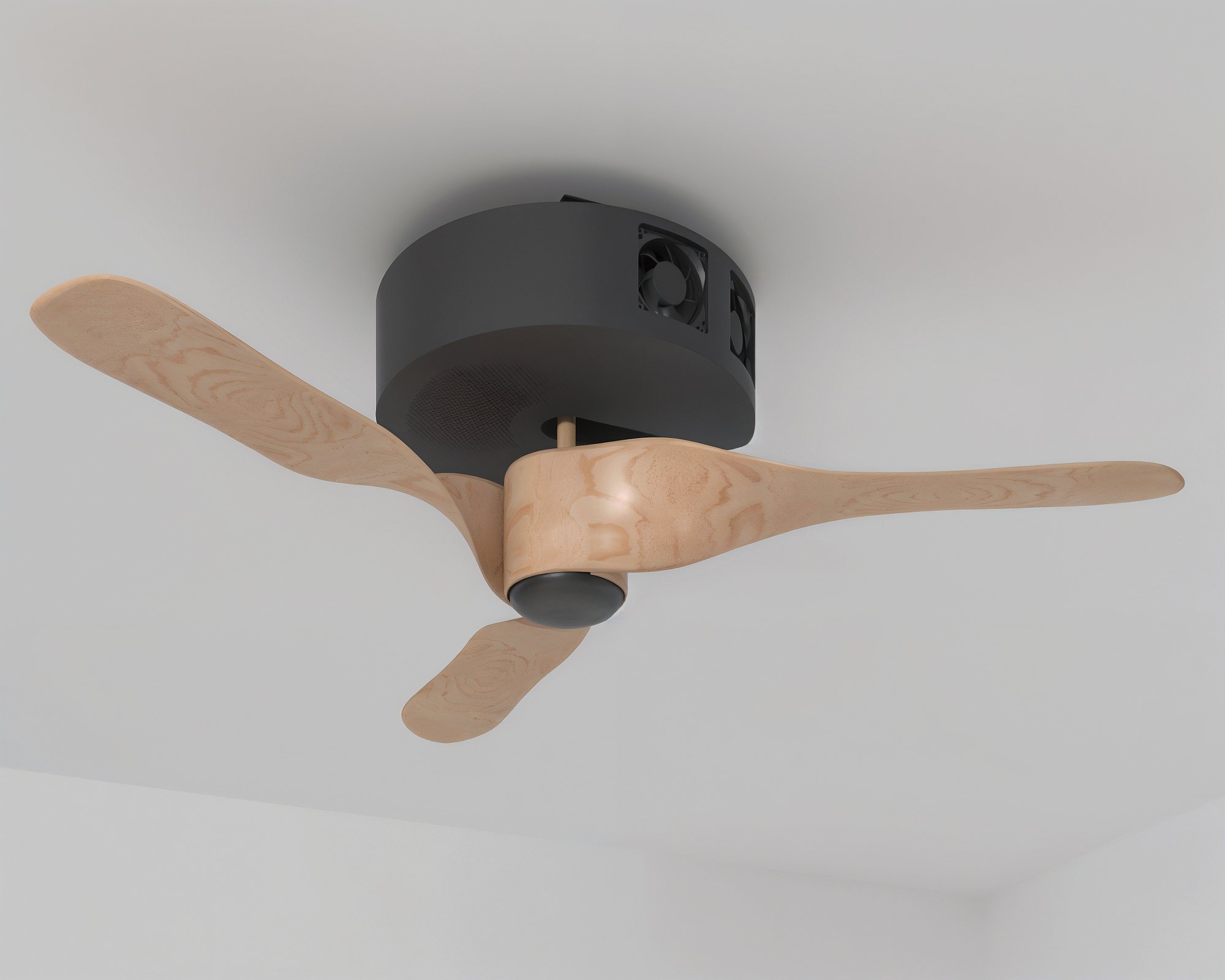 VAYU is a low-cost, personalised retrofit device that couples cooling and dehumidification through a desiccant wheel technology
VAYU is a low-cost, personalised retrofit device that couples cooling and dehumidification through a desiccant wheel technology
It claims to save 1,500–2,000 kg of CO2, 1,260 kg from operation, and 250–800 kg from manufacturing, if in operation for a decade.
7. EcoChill: Peltier-Based Water Cooler
In the hot climes of Rajasthan, this innovation by the students of BITS (Birla Institute of Technology and Science), Pilani promises respite to the people. Unlike conventional ACs that overcool entire spaces, ‘EcoChill’ is remote-controlled, easy to install, and built on wheels, thus enabling movement for focused cooling.
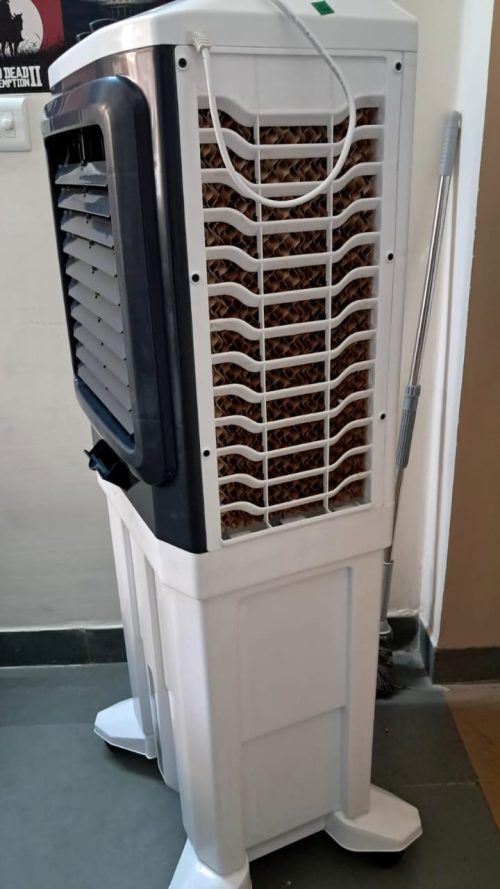 EcoChill is remote-controlled, easy to install, and built on wheels, thus enabling movement for focused cooling
EcoChill is remote-controlled, easy to install, and built on wheels, thus enabling movement for focused cooling
The prototype demonstrated a significant temperature reduction from 35 degrees Celsius to 26 degrees Celsius.
8. Solar-Responsive Thermal Curtain
Imagine a climate-proof blanket made from PVC (polyvinyl chloride) and steel rods that automatically opens and closes based on solar intensity! Not only have the students of the Indian Institute of Technology Delhi built such a device, but they’ve also tested it across 10 homes in two cities. They found energy reductions to be between 60 percent and 70 percent. This owes to the multi-layered insulation system with reflective, low-conductivity, and thermal mass materials.
9. Coolheart: Terracotta Cone-Based Cooler
Do you remember architect Monish Siripurapu, founder of Ant Studio design firm, whose air cooling system received United Nations acclaim? Well, the same principle of evaporative cooling — an ancient technique in which water is cooled by passing it through an earthen cone system — is now the premise of an innovation by the students of Bengaluru’s RV College of Architecture, RV College of Engineering, and RV University.
 Coolheart is a compact and modular cooler that uses terracotta cones combined with refrigerant-based cooling
Coolheart is a compact and modular cooler that uses terracotta cones combined with refrigerant-based cooling
‘Coolheart’ is a compact and modular cooler that uses terracotta cones combined with refrigerant-based cooling, capable of providing localised indoor cooling. The plug-n-play unit consumes 600-1200 watts, resulting in consistently low energy bills, a great bet for low-resource residential settings.
10. SheetalVayu: Sustainable Jali Shading Device
Whether it’s the stepwells of Rajasthan or the mosque, palaces and cenotaphs of ancient India, the jali weaves a beautiful story through the history of Indian architecture. Sometimes as sun breakers, other times as shades, the jalis encourage heat dissipation techniques. The students of Mumbai’s NMIMS’s Mukesh Patel School of Technology Management & Engineering and NMIMS’s Balwant Sheth School of Architecture developed a jali-based shading device for windows, a homage to the classics.
Constructed from sustainable materials, the ‘SheetalVayu’ prototype showed a reduction of indoor temperatures by two and a half degrees Celsius with 14.8 percent water absorption aided cooling.
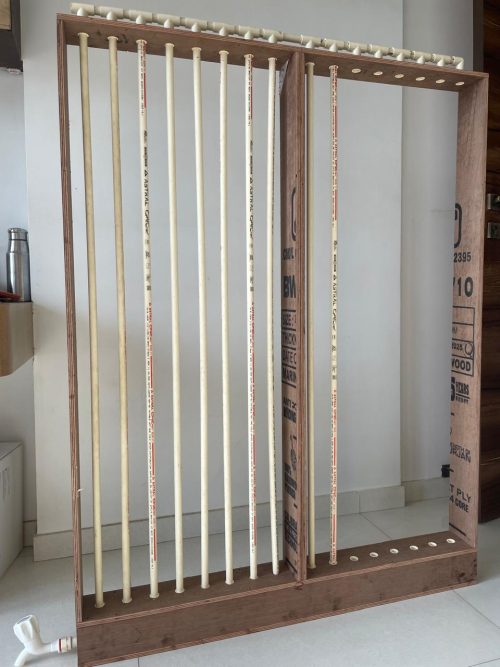 SheetalVayu is a jali-based shading device for windows
SheetalVayu is a jali-based shading device for windows
Since its inception in 2020, SDI has grown into the world’s largest net-zero building challenge, with over 8,200 students from 300+ institutions collaborating with 400+ partners in the building industry. It shows us that climate action doesn’t always need massive infrastructure or big budgets. All it takes is an idea, a classroom, and a commitment towards a sustainable future. With every prototype, these young innovators are stitching together a future that’s cooler, greener, and within reach.
Edited by Saumya Singh; All images courtesy AEEE
Sources
News